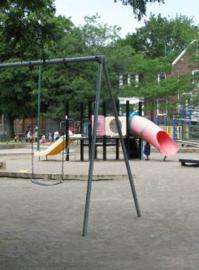Places to play, but 'stranger danger' fears keep inner-city kids home

(PhysOrg.com) -- Kids and teens in inner-city neighbourhoods have parks and places in which to play and be physically active, but their perceptions of "stranger danger" keep many of them away.
To Nick Holt, that's cause for concern.
"Evidence shows that Canadian kids have very low physical activity levels," said Holt, who led a two-year, in-depth study of an Edmonton inner-city neighbourhood, looking at perceived physical activity opportunities and barriers for inner-city youth. "Almost 90 per cent of Canadian kids don't meet the national physical activity requirement for 90 minutes of moderate to vigorous physical activity per day. This is particularly problematic in low-income neighbourhoods."
Researchers talked to 59 inner-city children and youth from one elementary/junior high school, teachers and other staff at the school, and youth workers in physical activity programs about their real-life experiences. Holt says the data revealed three themes that influenced youngsters' opportunities for physical activity: neighbourhood characteristics, family involvement and adult-supervised programs.
Surprisingly, inner-city neighbourhoods scored 10/10 for "walkability," says Holt. "They had good mixed-land use, good urban design with sidewalks, good urban density. People could walk to shops and playgrounds and there were lots of play spaces.
"The negatives were related to human factors. Kids' perceived safety concerns included drug users 'tweaking,' or acting erratically, prostitutes, bullies, gang members and the fear of being abducted. Children spoke about seeing evidence of drug use in play areas, such as syringes, prompting concerns about playing there.
"When you've got dangerous people hanging around playgrounds, kids aren't going to go to them."
Holt also found that children and youth were seldom allowed out alone, but, he says, "We found that if kids were accompanied by a family member, this facilitated their engagement in physical activity. That's when they talked about what opportunities they had to be physically active."
Playing at home was important to inner-city kids, Holt noted, adding that the older neighbourhoods in which the kids lived had large backyards, a definite plus. "Seen in the wider context, if it is dangerous to go across the road to play in the park, being able to play at home becomes even more important," he said.
Youth-oriented programs, from those run locally from church basements to national organizations' offerings, provided opportunities for adult-supervised physical activity, Holt found. "They are working hard and doing a fantastic job, in many cases with very few resources," he said.
Holt says the study findings will be shared with non-profit organizations and stakeholders to develop community strategies to address the issues uncovered by the study. "This has been a community project throughout," he said. "We worked with the community right from the start. The idea came from the community, and now we taking the findings back to those communities and developing strategies."
As a next step, working with the Edmonton Public School Board and KidSport Alberta, one of Holt's graduate students will create, deliver and evaluate a sport-based "critical hours" program, which has the goal of teaching life skills in the city's most needy schools.
Holt stresses that though the study looked at one inner-city Edmonton neighbourhood in-depth, the inner-city neighbourhoods in other metropolitan areas in Canada bear similar characteristics, and the study data can be broadly used to tackle physical activity barriers for inner-city children and youth.
The study, "Neighbourhood physical activity opportunities for inner-city children and youth" will be published in the December issue of the international journal, Health and Place.
Provided by University of Alberta (news : web)















